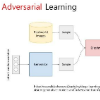We introduce an adversarial learning framework, which we named KBGAN, to improve the performances of a wide range of existing knowledge graph embedding models. Because knowledge graph datasets typically only contain positive facts, sampling useful negative training examples is a non-trivial task. Replacing the head or tail entity of a fact with a uniformly randomly selected entity is a conventional method for generating negative facts used by many previous works, but the majority of negative facts generated in this way can be easily discriminated from positive facts, and will contribute little towards the training. Inspired by generative adversarial networks (GANs), we use one knowledge graph embedding model as a negative sample generator to assist the training of our desired model, which acts as the discriminator in GANs. The objective of the generator is to generate difficult negative samples that can maximize their likeliness determined by the discriminator, while the discriminator minimizes its training loss. This framework is independent of the concrete form of generator and discriminator, and therefore can utilize a wide variety of knowledge graph embedding models as its building blocks. In experiments, we adversarially train two translation-based models, TransE and TransD, each with assistance from one of the two probability-based models, DistMult and ComplEx. We evaluate the performances of KBGAN on the link prediction task, using three knowledge base completion datasets: FB15k-237, WN18 and WN18RR. Experimental results show that adversarial training substantially improves the performances of target embedding models under various settings.
翻译:我们推出了一个对抗性学习框架,我们称之为KBGAN, 目的是改进现有知识图嵌入模型的广泛范围。 因为知识图数据集通常只包含正面事实, 抽样使用有用的负面培训实例是一项非三重任务。 将事实的首级或尾部实体替换成一个统一随机选择的实体是一个常规方法, 用来产生许多以前作品所使用的负面事实, 但以这种方式产生的大多数负面事实很容易与正面事实区分开来, 并且对培训贡献甚微。 受基因化对抗网络( GANs) 的启发, 我们使用一个知识图嵌入模型作为负面样本生成器, 协助培训我们所希望的模型, 这模型在GANs中起着指导作用。 生成者的目标是生成困难的负面样本, 使歧视者能够最大限度地增加其先前许多作品中所确定的相似性, 而歧视者则最大限度地减少其培训损失。 这个框架独立于生成者和制导师的具体形式, 因此, 能够使用多种知识图形嵌入模型作为其建筑块。 在实验中, 我们用两个对正对的实验性实验性实验性实验性实验模型, 用两个基于翻译的模型, Train-G Trans- train train train train train train train train train 3 train sal sal sal sal squal squewmal sal squal squal squald the:


